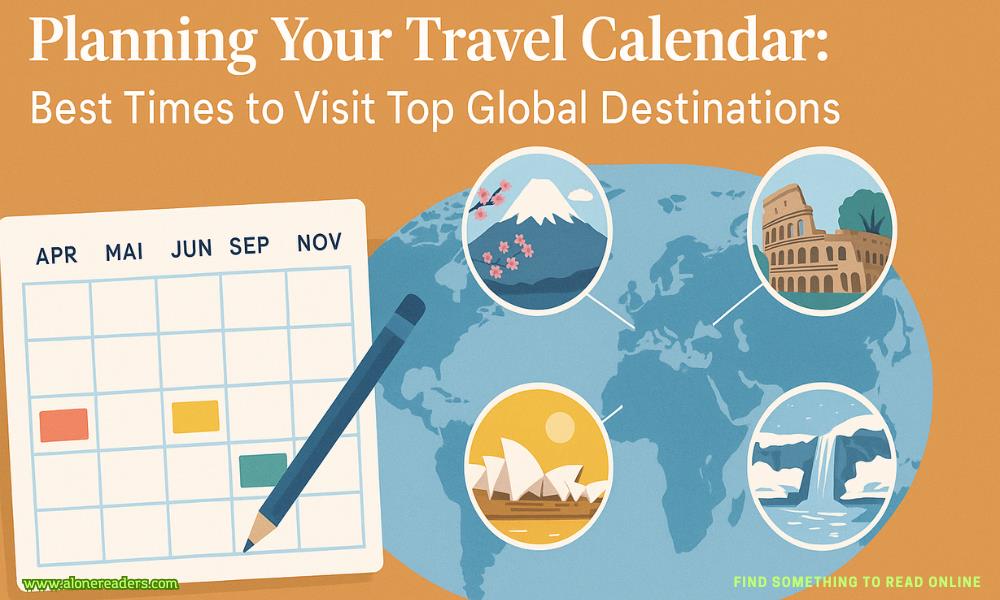
Travel is not just about where you go—but also when. The timing of your visit can dramatically impact everything from weather and crowd levels to cultural experiences and travel costs. In this in-depth guide, we focus on ten globally popular travel destinations and the optimal times to visit each based on climate, events, and local activity calendars. If you're planning your 2025 or 2026 travel calendar, use this as a highly specific guide—not a generalized roundup.
Cherry Blossom Season (Late March – Early April):
Japan’s most iconic season is spring, especially the cherry blossom (sakura) bloom. Tokyo, Kyoto, and Osaka erupt in soft pinks, and the country hosts hanami festivals. For travelers, this period combines mild weather (10°C to 18°C) with stunning visuals. However, it's essential to book flights and accommodations 3–4 months in advance due to high demand.
Autumn Foliage (Mid-November):
For a quieter and equally scenic experience, Japan’s fall foliage season in November is breathtaking. Places like Nikko and Kyoto glow with red and orange maple leaves. The air is crisp (8°C to 16°C), and temple visits are especially peaceful.
Spring (May):
Italy in May offers the perfect balance: blooming countryside, moderate temperatures (15°C to 25°C), and relatively fewer crowds. The Amalfi Coast, Tuscany, and Rome are all in full swing without the suffocating heat of July-August. Wine regions such as Piedmont and Chianti begin to buzz with activity.
Early Autumn (September):
September marks the grape harvest in regions like Tuscany and Umbria. It's warm (20°C to 28°C), with summer crowds thinning. Venice sees more navigable canals and fewer tourists, making it ideal for romantic trips.
Pre-Summer (Late October to Early December):
Australia’s spring is a golden window—especially for cities like Sydney, Melbourne, and Hobart. Temperatures range from 18°C to 27°C, with beaches becoming lively but not overcrowded. Major events like the Melbourne Cup and Sculpture by the Sea in Sydney take place in this season.
Post-Summer (March):
March is perfect for exploring Tasmania, the Great Ocean Road, and national parks like the Blue Mountains. It's also harvest time in Australian wine country (Barossa Valley and Margaret River), ideal for food and wine lovers.
Summer (Late June to Mid-August):
The Icelandic summer is magical, offering 20+ hours of daylight and accessible roads to remote attractions. Temperatures hover around 10°C to 15°C—pleasant enough for hiking in Þórsmörk or exploring the Westfjords. This is also prime whale-watching season in Húsavík.
Tip: Prices peak during this period, so budget travelers should consider shoulder weeks in early June or late August.
Cool Season (Late November to February):
Thailand’s monsoon ends by November, leaving behind lush landscapes and clear skies. Chiang Mai’s Yi Peng lantern festival in November is a visual delight. Beach destinations like Krabi, Koh Lanta, and Phuket are ideal during this season, with sea temperatures around 28°C and air temperatures between 22°C and 31°C.
Dry Season (May to September):
To trek the Inca Trail or visit Machu Picchu with minimal disruption, the dry season is key. May and June offer bright days (15°C to 21°C in Cusco) and fewer crowds compared to July-August. High-altitude sun can be intense, so proper gear is essential.
June Bonus: The Inti Raymi (Festival of the Sun) in Cusco is held on June 24th—a powerful cultural experience that attracts global visitors.
Spring Wildlife Viewing (September – November):
For safari lovers, the shoulder season from September to November provides excellent wildlife sightings in Kruger and Addo parks. Temperatures are warm (20°C to 28°C), and game drives are more rewarding due to thinner foliage.
May for Cape Town:
May brings post-summer tranquility to Cape Town, with crisp air, lower prices, and uncrowded vineyards in Stellenbosch and Franschhoek.
Summer (Late June – Early September):
If you want to explore Banff, Jasper, and the Canadian Rockies, this is the only time when hiking trails are fully accessible. Temperatures range from 15°C to 25°C, and national parks are alive with activities.
Autumn (October):
Eastern Canada (Ontario, Quebec) becomes a painter’s dream, especially in Algonquin Park. Cooler temperatures (5°C to 15°C) bring in photographers and nature lovers.
Spring (March to May):
Marrakech, Fez, and the Atlas Mountains are best experienced in spring when the air is fresh and gardens are in bloom. Temperatures hover around 22°C to 28°C, perfect for medina exploration and desert trips.
Autumn (October):
October sees a dip in heat, making Sahara Desert trips more comfortable. It’s also olive harvest season, especially notable in the countryside near Meknes.
Early Summer (Late May – June):
The Greek islands like Santorini, Paros, and Naxos are still relatively quiet, with mild seas and temperatures around 24°C to 30°C. Ferries operate smoothly, and accommodation is cheaper than in high summer.
Late Summer (Mid-September):
Sea temperatures are still warm, the crowds are gone, and island life regains its slow, authentic rhythm. Athens becomes tolerable again, and archaeological sites like Delphi and Epidaurus are enjoyable without oppressive heat.
Avoid School Holidays:
Global school breaks (July-August, Christmas, Easter) lead to inflated prices and packed attractions. Planning around these can save you both money and sanity.
Use Local Event Calendars:
Festivals like Holi in India (March), Carnival in Brazil (February), and Oktoberfest in Germany (late September) define their locations—so align your calendar accordingly if cultural immersion is part of your goal.
Monitor Visa Timelines:
Some destinations (e.g., USA, Canada, China) require advance visa applications. Factor processing time into your travel calendar to avoid last-minute issues.
Travel Insurance & Health Checks:
For tropical and high-altitude destinations, always account for vaccinations, insurance requirements, and acclimatization days.